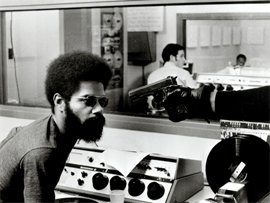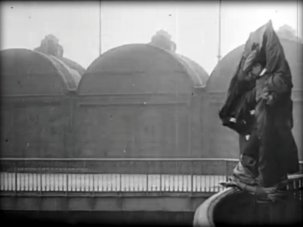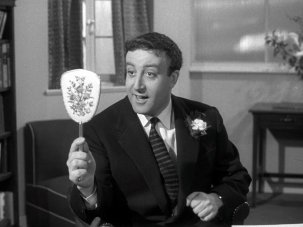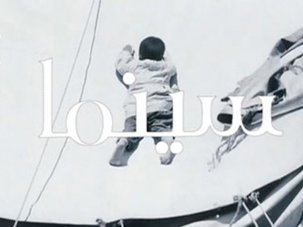Web exclusive
![[Bert Williams Lime Kiln Club Field Day] (1913) [Bert Williams Lime Kiln Club Field Day] (1913)](https://www2.bfi.org.uk/sites/bfi.org.uk/files/styles/full/public/image/bert-williams-lime-kiln-club-field-day-1913-001-cue-card-with-odessa-warren-grey-and-bert-williams-in-front-of-crowd.jpg?itok=QUC319GL)
[Bert Williams Lime Kiln Club Field Day] (1913)
“[Bert Williams] was the funniest man I ever saw – and the saddest man I ever knew”
“You haven’t the faintest conception of the difficulties which we must overcome, of the prejudices which must be left slumbering, of the things we must avoid whenever we write or sing a piece of music, put on a play or a sketch, walk out in the street or land in a new town”
— Aida Overton Walker, Indianapolis Freeman, 6 October 1900
The exhibition 100 Years in Post-Production: Resurrecting a Lost Landmark of Black Film History runs October 24, 2014-March 31, 2015 at MoMA, New York, USA.
The film [Bert Williams Lime Kiln Club Field Day] (1913) is repeated on Friday 16 January 2015 at MoMA.
“I would like it to go viral, to tour the world. It needs to get out there,” says Ronald S. Magliozzi, associate film curator at New York’s Museum of Modern Art (MoMA). We’ve just met, and our conversation is seconds old, but his eyes are already wide with excitement. “We would like to give it back to the community, the black artists. I had a vision of giving it to important black artists and have them edit it, and sample from it, and do whatever they want to it.”
He’s animatedly referring to the next potential stage of a project which has kept him busy for a decade: the discovery of seven reels of previously unidentified, 101-year-old film footage, the earliest known surviving feature film with a cast of black actors, among them legendary vaudevillian Bert Williams [1]. It is the focus of an ongoing exhibition, 100 Years in Post-Production: Resurrecting a Lost Landmark of Black Film History. The film, which Magliozzi and team have sculpted from the rushes, is a precious visual depiction of middle-class black characters from an era when lynchings and racial stereotypes were rife. It came untitled, so the curators have dubbed it ‘Bert Williams Lime Kiln Club Field Day’, a reference to a fictional comedy club which repeatedly surfaced in their research.
(A few weeks after our conversation, the film is added to the US Library of Congress’s National Film Registry, where works are selected for preservation on account of their cultural, historic or aesthetic qualities.)
Digging in
Magliozzi explains that the unedited, silent, non-intertitled daily rushes – multiple takes captured each day during production – were found among a hoard of 900 negatives that had been acquired from the pioneering Biograph studio by MoMA’s founding film curator, Iris Barry, in 1939; ironically, she’d been scouring for work by D.W. Griffith, the director of virulently racist epic The Birth of a Nation (1915). Barry got there just in time: the rushes were on the brink of destruction, for Biograph’s facilities in the Bronx had recently closed for business.
Later, in the 1970s, the rushes were printed onto safety film stock, and in the 1980s underwent the process of restoration. Magliozzi began the process of assemblage in 2004. It was at this point he realised the unique nature of Barry’s unearthing. Though a few other films from that period featured black casts, including Alice Guy-Blaché’s A Fool and his Money (1912), and a smattering of micro-budget efforts by black independent directors like William Foster and Hunter C. Haynes, they’re all now considered lost.
![[Bert Williams Lime Kiln Club Field Day] (1913) [Bert Williams Lime Kiln Club Field Day] (1913)](https://www2.bfi.org.uk/sites/bfi.org.uk/files/styles/full/public/image/bert-williams-lime-kiln-club-field-day-1913-007-production-scene-with-band-and-bert-williams-talking.jpg?itok=ZN3FVbZx)
[Bert Williams Lime Kiln Club Field Day] (1913)
Even more extraordinarily, hidden within the material were nearly a hundred stills depicting the black cast and white crew happily mingling on set, several frames of Williams interacting with white extras on location during a filming break – remarkable considering established narratives about the Jim Crow era’s poisonous racial dynamics – and startling images of Williams having his blackface applied by a valet. Williams, a major Broadway star by this juncture, was replicating the established stage tradition of blacking up, yet was the only cast member to do so. (“A sop to the white audience,” says Magliozzi, explaining this bizarre contrivance. “The fact that the lead wore blackface allowed the rest of the cast not to wear blackface before white audiences.”)
The rushes also include almost eight minutes of documentary footage – a sort of proto ‘making-of’ depicting the cast and crew at the New York studio sets and suburban New Jersey locations. This compelling material makes up the vast majority of the exhibition, which is sequenced, elegantly and austerely, across two gallery floors.
Magliozzi characterises the process of researching the exhibition as a “detective story” – very little information about the production and its history was readily obvious from the raw material. The identification of the cast, which he estimates comprising between 50 and 100 performers, began with comparing frames of the film with images of sheet music and old press photographs, which were often to be found in the pages of Harlem’s black newspaper New York Age. One was J. Leubrie Hill, who ran the Darktown Follies stage company. Another was the regal female lead Odessa Warren Grey, who, as a number of later trade ads confirmed, became a successful businesswoman in the fashion field, and a known associate of proto-black feminist and stage performer Aida Overton Walker.
![[Bert Williams Lime Kiln Club Field Day] (1913) [Bert Williams Lime Kiln Club Field Day] (1913)](https://www2.bfi.org.uk/sites/bfi.org.uk/files/styles/full/public/image/bert-williams-lime-kiln-club-field-day-1913-006-production-still-bert-williams-and-odessa-warren-grey-together.jpg?itok=-vGBakA1)
[Bert Williams Lime Kiln Club Field Day] (1913)
It eventually transpired that much of the cast had emerged from a little-known group of Harlem artists who, for years, had their events (concerts, carnivals, exhibitions) covered in the Age. The curator finds this particularly exciting, with good reason: “It brings to the world’s attention this… small community that’s pre-Harlem Renaissance, and before the blues and jazz were officially identified as that. We’re talking about the ragtime period.” The process of discovering all the cast members remains ongoing.
Magliozzi and his team were able to discern that the film was shot in 1913 from three distinct threads of research. The last films shot with Biograph’s trademark ‘one-hole’ camera – as this one was – were all made near the end of the year; a perusal of Williams’ 1913-14 recording and performance schedule suggested he was both free and in New York in August that year; and an August 1914 obituary for production team member Sam Corker Jr., who is believed to have perished after falling off a ladder, provided the sole concrete written reference to the film: “Last fall [Corker Jr.] employed a large group of colored performers for the ‘Lime Kiln Club’ series of motion pictures… in which Bert A. Williams was featured”.
The obituary has been enlarged, and printed in full, near the entrance of the exhibition, and it struck me as a particularly powerful statement of intent – a strong reminder of the importance of black behind-the-scenes involvement to complement the top-line attraction of the charismatic Williams. It also includes the line: “Corker Jr. was a fitting representative for that branch of theatricals with which few members of the race are identified or conversant – the business end.” These sentiments resonate today, when issues around a lack of industry diversity, particularly at executive level, remain depressingly pertinent. Elsewhere, Magliozzi and co. were able to discern the involvement of white producers T. Hayes Hunter from prolific New York company Klaw and Erlanger, and Edwin Middleton from Biograph – these men strike a host of grandly authoritative poses in the behind-the-scenes snaps.
![[Bert Williams Lime Kiln Club Field Day] (1913) [Bert Williams Lime Kiln Club Field Day] (1913)](https://www2.bfi.org.uk/sites/bfi.org.uk/files/styles/full/public/image/bert-williams-lime-kiln-club-field-day-1913-005-gathering-of-men-in-study-with-lincoln-busts.jpg?itok=Of3rmhQM)
[Bert Williams Lime Kiln Club Field Day] (1913)
Though Bert Williams’ story required less in-depth research – Magliozzi suggests that “he and Booker T. Washington were the two most famous black men of their day” – it’s no less fascinating. Following the premature death of his long-term performance partner George Walker in 1911, Williams went on to break the colour barrier as a black lead in the otherwise white-only casts of the Ziegfeld Follies from 1910 to 1919, where he was widely lauded for his expressive performance style, even as he was criticised in some quarters for his participation in art which reinforced negative racial stereotypes [2].
Williams’ intermittent dalliances with film, for example, were not to everybody’s taste. Fascinatingly, MoMA’s exhibition includes looped footage from two Biograph shorts named Fish and A Natural Born Gambler (both 1916), which locked Williams into more overtly stereotyped roles of the era [3]. A wall-mounted caption in the exhibition republishes a critique of Williams by an African-American reviewer for the Chicago Reader: “The great ability of Bert Williams loses its charm on the screen [and]… again demonstrates that moving picture directors know very little about what to do with the ‘brother’ on celluloid”. This summation seems to reveal less frustration with Williams than it does with the mainstream white forces attempting to harness his talents. It also reveals the presence of a lively critical discourse within the black press of the age.
Sharing the joy
The premiere public screening of the rushes (digital moving-image excerpts from the 35mm camera negative, including multiple takes, assembled in a semblance of narrative order) took place on the evening of Saturday 8 November as part of the institution’s 12th annual To Save and Project festival of film preservation. The MoMA’s Roy and Nita Titus auditorium – an impressive 400-seater – was full, and buzzing with a mixture of races and ages: my screening neighbour, for example, was an excitable septuagenarian gent from Mumbai who regaled me at length with tales of a recent MoMA event about Iris Barry. A sizeable chunk of the lengthy standby queue was left disappointed, although an encore performance in January 2015 was swiftly announced.
Before the screening, Magliozzi and MoMA film preservation officer Peter Williamson further contextualised the film and its participants. One of the most chilling images in their slideshow depicted Williams in a print advertisement which championed him as an exclusive Columbia Records artist. In it, Williams sits in the foreground, free of the burnt cork, smiling gently. High in a mirror in the background, however, we see an image of Williams’ blackface alter-ego looming down. The juxtaposition is clearly intended as an innocuous reference to his widely-loved comic creations, but the effect today is horrifying – it’s the ghoul in the reflection from whom Williams could never escape [4].
In a contrasting register, Magliozzi drew a huge collective belly laugh by revealing that a lip-reader hired to glean the film’s dialogue emerged with more contemporary-style findings than anyone had imagined: “Get the fuck out of here!”, and “Where the fuck is my money?” were among the pearls deciphered.
![[Bert Williams Lime Kiln Club Field Day] (1913) [Bert Williams Lime Kiln Club Field Day] (1913)](https://www2.bfi.org.uk/sites/bfi.org.uk/files/styles/full/public/image/bert-williams-lime-kiln-club-field-day-1913-004-marching-band-chaos.jpg?itok=Z_bLBdXm)
[Bert Williams Lime Kiln Club Field Day] (1913)
The men discussed the potential reasons for the film’s incomplete state, citing production delays and funding issues. Magliozzi argued that the 1915 release of Griffith’s Birth of a Nation had a disastrous effect on American race relations, effectively poisoned the well for progressive filmmakers, and calcified a template for negative black character types. Historian Donald Bogle explains: “With Birth, all the major screen types had been introduced. Literal and unimaginative as some types may now appear, the naive and cinematically untutored audiences of the early part of the century responded to the character types as if they were the real thing.”
In the light of this, it seems the Lime Kiln club film simply wasn’t overtly racist enough. As a canny prelude to the screening, in order to contrast the rank perversion of Birth’s portrayal of black characters with the forthcoming main attraction, the curators ran an infamous clip from Griffith’s film: the shocking Congressional session, in which the freed Negro legislators are depicted as lustful, incompetent and arrogant [5].
The film itself, accompanied here by a jaunty live piano score from Donald Sosin, humorously follows the travails of a top-hatted dandy and perennial schemer (Williams) who vies with two other suitors – one a dead ringer for a young Denzel Washington – for an elegant lady (Grey). Williams’ character’s chief obstacles seem to be his own bungling ineptitude, and his would-be paramour’s disapproving mother.
![[Bert Williams Lime Kiln Club Field Day] (1913) [Bert Williams Lime Kiln Club Field Day] (1913)](https://www2.bfi.org.uk/sites/bfi.org.uk/files/styles/full/public/image/bert-williams-lime-kiln-club-field-day-1913-003-odessa-warren-grey-with-three-suitors.jpg?itok=QTsi6Jn0)
[Bert Williams Lime Kiln Club Field Day] (1913)
The film features a host of drily amusing domestic scenes, gatherings at a social club, a long comic set piece about Williams’ ‘discovery’ of a gin well and, at most length, a carefree day at a fair. The fair scenes exhibit some of the most jarringly regressive stereotypes associated with black performers, including an ululating throng wrestling for loose shoes and a greased pig, a watermelon eating contest and a 100-yard dash in which Williams clownishly bests his pint-sized competitor.
Yet the overall tone is restrained and measured, and the laughs mostly come organically, from the carefully-seeded set-ups, and Williams’ expert comic timing and hilariously precise facial expressions – he seems a clear influence on the likes of Charlie Chaplin and Harold Lloyd. In one transcendent scene featuring Williams and Grey flying around and flirting on a merry-go-round, I was temporarily able to forget completely the vexing context of Williams’ blackface. The film is also notable for featuring a joyous, two-minute-long, full-cast cakewalk, the traditional African-American dance which was popularised as early as 1900 by Williams, Walker and Aida Overton Walker.
One striking result of the curators’ choice to include multiple takes is to render the film’s ostensible simplicity a tantalisingly enigmatic slice of experimenta in its own right. Scenes pile up in layers, changing imperceptibly from moment to moment, hinting at a host of might-have-beens. Borderline subliminal, split-second flashes of an out-of-character Williams smiling warmly at the camera meanwhile carry a hauntological quality, as though there are ghosts in the fabric of the film talking to us today.
![[Bert Williams Lime Kiln Club Field Day] (1913) [Bert Williams Lime Kiln Club Field Day] (1913)](https://www2.bfi.org.uk/sites/bfi.org.uk/files/styles/full/public/image/bert-williams-lime-kiln-club-field-day-1913-002-production-still-odessa-warren-grey-feeding-bert-williams-lollipop-on-merry-go-round.jpg?itok=3FEpxTNO)
[Bert Williams Lime Kiln Club Field Day] (1913)
This sense of alternate pasts and futures mingling is most apparent in the gorgeous final sequence(s), when Williams may or may not get his girl – three competing takes make it unclear whether the long, tender kisses the couple share are a work of Williams’ character’s imagination. Even so, the effect is mightily stirring. “There’s so much joy that we rarely ever see in films about black people,” Deborah Willis, the NYU chair of photography and imaging, told National Public Radio. “To see a black man and black woman kissing – it’s an intimacy that we rarely see in black film again during that time period.” Arguably, it’s the sort of vision we don’t see enough of today.
Indeed, it was that final image of Williams and Grey – smiling, lips pressed together, caught in some ineffable locked groove between performance, reality, romance and laughter – which stayed with me long after I left the auditorium and disappeared into the midtown Manhattan bustle.
Notes and a clip
1. Williams was, in fact, born in Nassau, Bahamas, to Danish and West Indian parents in 1874, meaning that he was mixed-race. MoMA’s press notes refer to Williams’ onstage persona as “a mask he wore throughout his performing career, even in the 80 very popular recordings he made for Columbia records”. Referring to Williams as ‘black’ simply illustrates the sheer complexity of discussing race and representation, yet the use of this terminology is a hedge that must do for the purposes of discussing this exhibition: Williams would have been considered ‘black’ by the era’s audiences, and perhaps would widely be considered so today. [Back]
2. Williams’ name is invoked on a number of occasions in Spike Lee’s contemporary blackface satire Bamboozled (2000), and appears in the closing montage of blackface performers. Magliozzi tells me that he was a little irritated by what he felt to be the film’s overly negative viewpoint of Williams. [Back]
3. The title of Donald Bogle’s classic book Toms, Coons, Mulattoes, Mammies and Bucks succinctly delineates these core, enduring stereotypes. In the shorts, Williams, despite his evidently excellent comic timing and remarkable range of facial expressions, displays the clownish bearing of the ‘Coon’, and, particularly in Fish, the accommodationist impulse of the ‘Tom’. To underscore their authenticity as compared to white men in blackface, Williams and Walker were earlier known to bill themselves as “Two Real Coons”. Back]
4. Village Voice theatre critic Michael Feingold wrote of Williams in 2008: “Melancholy was his stock in trade. All his songs deal with misery, pain, and violence, usually visited on him. His primary activity in performance consisted of being lured from one hideous situation into a worse one. Onstage, his melancholy made audiences laugh immeasurably; offstage, a deeply inward soul, he carried it with him.” [Back]
5. MoMA itself temporarily shelved Birth of a Nation in 1946 “[T]he potency of its anti-Negro bias…” read the Museum’s press announcement, “exhibiting it at this time of heightened social tensions cannot be justified.” [Back]
-
The Digital Edition and Archive quick link
Log in here to your digital edition and archive subscription, take a look at the packages on offer and buy a subscription.








